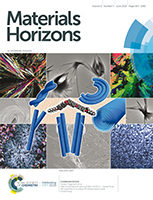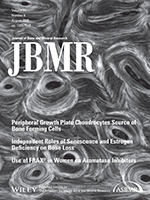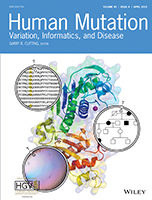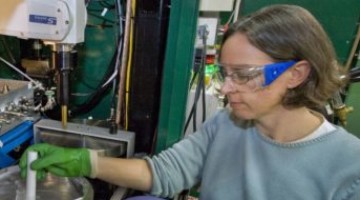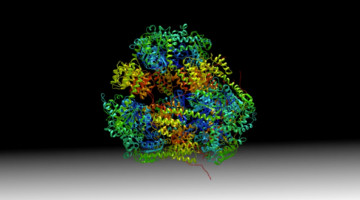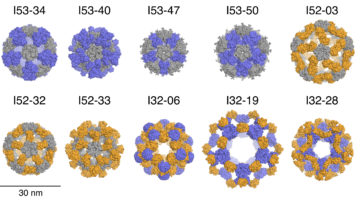Perovskite superlattices have a wide variety of applications, but they are difficult to synthesize. Researchers have now characterized their self-assembly process to better understand how to create a variety of superlattice materials. Read more »
Heliconical-layered nanocylinders (HLNCs) – hierarchical self-assembly in a unique B4 phase liquid crystal morphology
Morphology is of critical importance for molecular crystals, drug molecules, alloys, and elements in the periodic table. We here demonstrate how very subtle structural changes in a set of bent-core liquid crystals lead to rather complex hierarchical superstructures driven by changes in molecular conformation. Read more »
Exploring the “minimal” structure of a functional ADAMTS13 by mutagenesis and small-angle X-ray scattering
Researchers used the SIBYLS beamline to gain insight into ADAMTS13, the only known protein to regulate the adhesive function of von Willebrand factor (VWF), a blood-clotting protein. When VWF is deficient or abnormal, it causes a common inherited bleeding disorder, von Willebrand disease. VWF is also implicated in arterial and deep-vein thrombosis, stroke, atherosclerosis, sickle cell crisis, and sepsis. Read more »
Mechanical Competence and Bone Quality Develop During Skeletal Growth
Researchers explored how bone quality and mechanical competence progress during longitudinal bone growth. Deformation at the tissue, fibril, and mineral length scales was investigated with mechanical tensile tests during small and wide-angle x-ray scattering/diffraction (SAXS/WAXD) experiments, revealing dramatic differences in mechanical resistance with age. Read more »
Biochemical and structural characterization of two variants of uncertain significance in the PMS2 gene
The lack of information as to whether a genetic mutation is pathogenic or benign causes ambiguity during clinical diagnosis and hinders appropriate treatment. Here, researchers use several techniques, including small‐angle x‐ray scattering, to help classify genetic variants associated with an increased predisposition to certain cancers. Read more »
NIH Grant Will Enhance Structural Biology Research Experience for ALS Users
A recently awarded National Institutes of Health (NIH) grant will help integrate existing structural biology resources at the ALS to better serve users. The funds will help establish a centralized collaborative mechanism, called ALS-ENABLE, that will guide users through the most appropriate routes for answering their biological questions. Read more »
A Hollow Pyramid Unlocks Principles of Protein Architecture
Researchers have designed a hollow, pyramid-shaped protein with a controllable cavity size that could be useful in the capture and release of smaller compounds. The tools and techniques developed could be useful in analyzing and optimizing designed protein assemblies and understanding their behavior in solution. Read more »
The Smectic Phase of DNA “Nano-Nunchaku”
Researchers designed DNA sequences that self-assemble into a nanoparticle about 50 nm long, composed of two double-stranded DNA duplexes linked together by a single-stranded DNA filament. The nanoparticle resembles nunchaku—a traditional weapon of several martial arts—but 30 million times smaller. Read more »
A Molecular View of Sperm–Egg Fusion
Researchers have uncovered the first interactions between the human sperm and egg—the initial steps in the creation of human life. The discovery lays a foundation to better understand fertilization and could lead to the development of non-hormonal contraceptives. Read more »
Designed Protein Nanocages Inspired by Nature
Inspired by protein molecules observed in nature, researchers have now engineered ten large, 120-subunit, two-component protein complexes. These designed nanomaterials are attractive starting points for new approaches to targeted drug delivery, vaccine design, and bioenergy. Read more »
- « Previous Page
- 1
- …
- 4
- 5
- 6
- 7
- 8
- Next Page »

